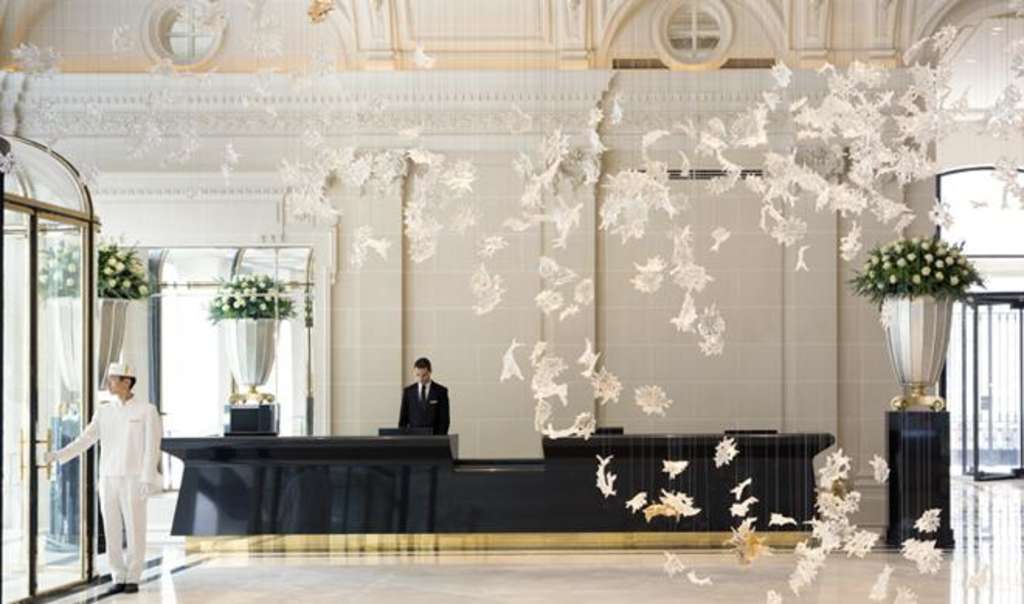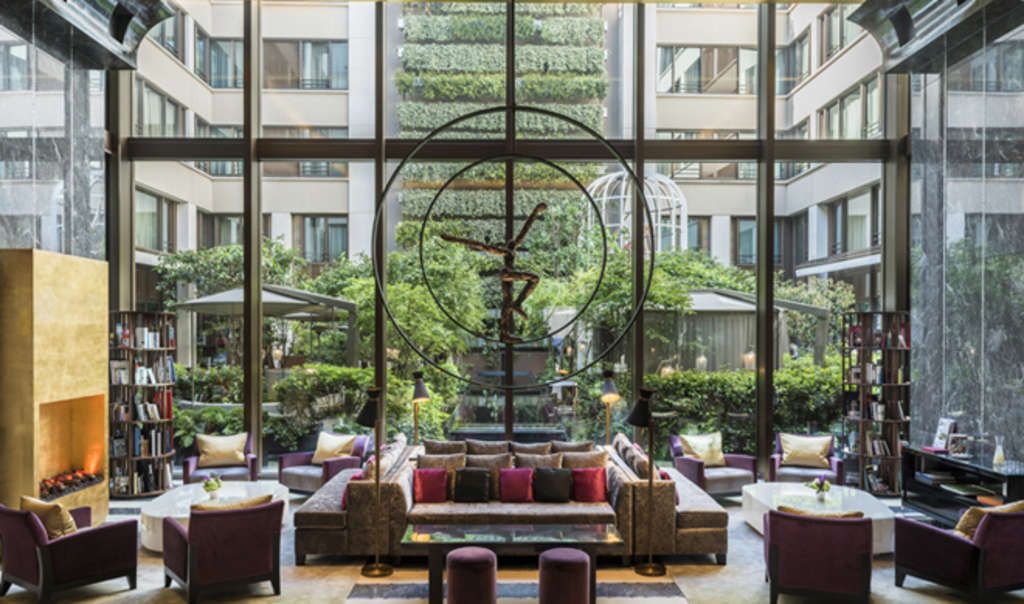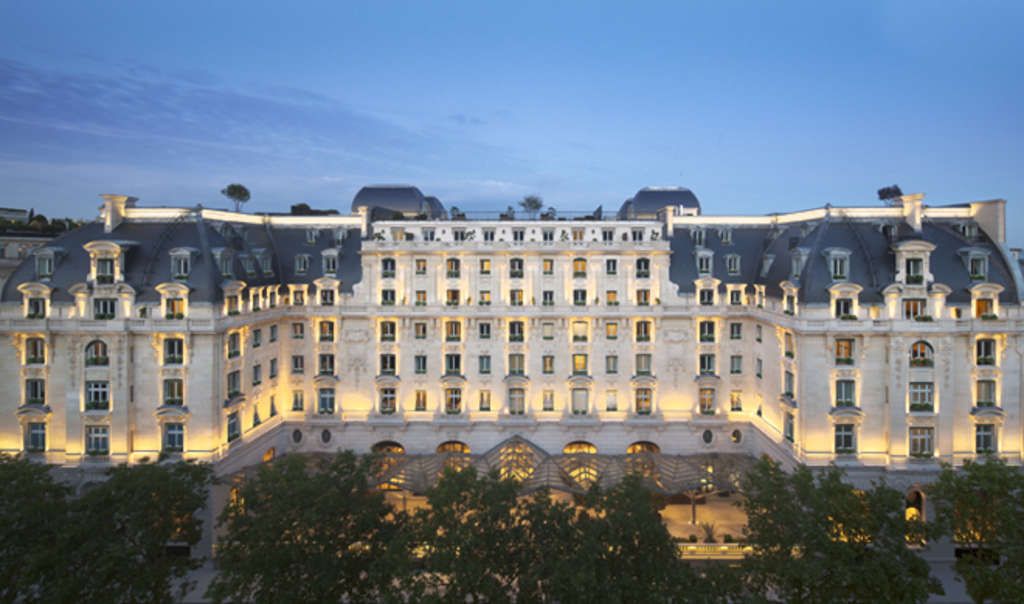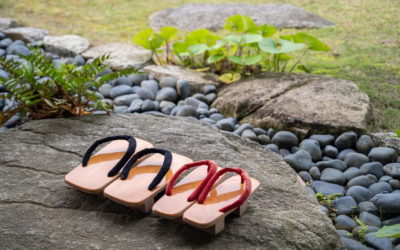
Entrance and lobby of The Peninsula, Paris.
In a series of pieces on luxury hospitality based on interviews with leading hoteliers in Paris, Suzanne Godfrey examines key pillars that define the luxury hotel, or more specially, the Palace. Here she explores the need for the soul – the tangible and intangible, something that’s not wholly definable.
So far we’ve examined two key pillars of luxury hospitality: quality and consistency; and service and the emotional connection. Here we turn our attention to the third and final pillar: the soul of the luxury hotel or Palace. It’s a concept that’s hard to define, a confluence of elements that uniquely come together. We’ve talked about some of these before in the earlier articles but here we will bring them together in the context of creating a soul. It’s a result of history and heritage; one reason why some people in the industry question whether the newer hotels in Paris – The Peninsula, Mandarin Oriental, and Shangri-La – deserve the official designation of “Palace”, simply because they are too new.
As Laurence Bloch, Deputy Manager of the Plaza Athénée, Paris, says in terms of the history of the hotel, “of course, for me, you need a soul.” At a new hotel, she adds, “you can’t create a soul. You have the ghost or you don’t have them … For me when I go into the Ritz Paris or the Bristol or the Plaza, it’s very different … to The Peninsula or Shangri-La.”
But it’s not just about history and heritage. It’s the result of other tangible elements: the location, the people – the creator and his or her vision, the clientele past and present, and employees – plus the resulting intangibles. Together, they make up the soul. This is not created overnight but as in all things luxury, it takes time. 50 years. 100 years. Or more…

The lobby at Mandarin Oriental, Paris.
Location: Where you are matters
According to Bloch, location is “very important for a luxury brand.” Your location makes a statement about who you are or who you aspire to be. It also defines your positioning in luxury. This applies to luxury hotels and not just Palaces, and is important for any luxury brand, not just in hospitality.
Take, for example, the locations of the Palace hotels in Paris. Their addresses range from the place Vendôme, rue St.- Honoré, rue de Rivoli, avenue Montaigne, avenue Kléber off la place Charles de Gaulle, avenue d’Iéna close to the Trocadéro, avenue George V, rue du Faubourg Saint-Honoré, place de la Concorde and avenue Hoche. Each arrondissement, each street – in fact its exact location on a street – brings with it a different character and a different expectation. For example, the Ritz: the center of haute joaillerie; the Plaza Athénée: haute couture; Le Meurice: art and culture, as well as reflecting the elegance of the Tuileries Garden; Le Royal Monceau Raffles: local and residential … And, as a result, the hotel attracts a different clientele. The location, a sense of destination, a “sense of place” is important.
François Delahaye, Chief Operating Office of the Dorchester Collection and General Manager of Plaza Athénée, Paris, also stresses the importance of location. The luxury hotel, he says, needs to have a sense of history: “You need to have life. You cannot create a Palace out of nowhere. You need to be in the center of what’s happening. Your hotel needs to be the place to be.”
He continues: “The hotel needs to be the place to be inside also. By having all those restaurants, all those bars, which are bringing the Parisian within the city to have a coffee, to have a gastronomic meal at Alain Ducasse, to have use of the spa, to have use of the restaurants. (For) foreigners, when they are choosing a hotel, I think what is important for them is to be in the middle of what is going on in Paris.”.
Heritage: Defining who you are
The hotel’s history and heritage define who you are and what you are. Together they enhance the brand and are the result of the creator, the people (employees, clientele), the location, and “things” that create the Palace, which are unique to the brand and the property.
As we highlighted in an earlier article on redefining luxury in hospitality, the brand’s heritage defines its unique signatures – what characterizes the hotel that is emblematic of the past and provides consistency into the future. For the Ritz Paris: the gold swan taps and room key, peach towels, the Hemingway and Ritz Bars, the acknowledgements to Coco Chanel that extend from the Coco Chanel Suite (almost always booked) to Chanel au Ritz, the newly-opened spa that offers the “art of skincare by Chanel.” For the Plaza Athénée: the color red and geraniums, the relationship with Dior that extends into expressions of haute couture and the Dior Institute. In everything there is a story that initially creates and then builds on the heritage of the hotel. For The Peninsula, Mandarin Oriental and Shangri-La, their heritage is of course Asian.
Heritage is also created through an iconic building, which has its own history and adds to the soul of individual properties.

A historic building: The Peninsula, Paris.
Luxury and the creator
Luxury is always about the creator – their vision and, ultimately, their creations; and is fundamental to who they are as a brand. The same is true for luxury hotels. Consider César Ritz. Or, Charles-Augustine Meurice, a French postmaster in the business of transportation. He recognized the need – and opportunity – for English guests traveling from London to Paris to have somewhere to rest on arrival. Hence the location of Le Meurice but also a hotel designed with the (English) traveler in mind, which included an English bar, more like a Gentleman’s club, where English was spoken.

The bar at Le Meurice, Paris.
The clientele: Creating history and myths
The clientele help create not just the history but also the hotel’s aura. They create the distance – important to luxury – and its reputation, and the aspiration. They lend the hotel a unique ambience and character, adding to the “ego” of the establishment. They help create the magic and the dream. They don’t need to be famous clients as such; all clients have the capacity to do this to some extent.
“(In) all those outstanding “old ladies” there is a soul and that soul can only be given by clients (famous or otherwise),.” says Delahaye. “I think there is a soul there. They are looking for something.”
The Ritz Paris, for example, had a number of literary and artistic clientele, along with well-known aristocrats, who have helped create the mythology and stamped their own mark on the place. From Charlie Chaplin to Chanel, from Proust to Hemmingway. The Plaza Athénée attracted its share of film stars and celebrities but also had links with the Théâtre des Champs-Élysées and the fashion world of Christian Dior. After the war, Dior gave his models money to hang around the bar at the Plaza, in order to be seen. The tactic (and gossip) worked and the relationship benefited both the hotel and the House of Dior.

The Coco Chanel suite at The Ritz, Paris.
But it’s not just about the past. Today’s clientele also have an impact on the soul of the hotel and its current ambience. As Aaron Kaupp, General Manager of Le Royal Monceau Raffles, explains, when you’re traveling you don’t want to be constantly surrounded by expats and tourists. He says the clientele at his hotel’s F&B outlets are all locals. “You want to hang out where the locals hang out. Because 95 per cent of the time, where the locals hang out are the authentic spots and it makes you really get to live the culture.” Whether past or present, the clients are important to creating the soul of the hotel.
The employees: Yesterday, today and tomorrow
Employees convey the hotel’s unique culture, its DNA and spirit. They deliver a particular style of service based on the brand’s values and its service philosophy. They reflect the past, they represent the present, and they help create the future.
Just to demonstrate how important employees are, the Ritz Paris rehired more than 200 people when the hotel reopened last year. Consequently, they now have a combination of “old” – or rather former staff – plus new staff. “Ex” staff have the knowledge and experience; retaining them was important. They help provide the familiarity and the recognition – as a guest, you know them and they know you. They have the “memory”, which helps deliver the personal service and consistency. “Guests find the same service but with a little twist, something different … (because) we introduced new trends, new things,” says Jean-Pierre Trevisan, the hotel’s Director of Operations.
It’s not just about qualifications and diplomas – although they help of course. Sébastien Chebaiki, who handles guest relations at the Plaza Athénée, Paris, says: “It’s about knowing your client, plus (having) a genuine attitude. You do it because you want to do it and not because you get paid for it. It’s about the detail. Just small things … It’s understanding the psychology of the guest.” That means having the right attitude and possessing the human touch. This isn’t something you can accomplish through training. It’s about being innovative, caring, passionate and committed. In short, it’s more than just a job.
It’s also about giving employees the autonomy to make decisions on the spot and be empowered to act spontaneously on them. That comes with trust; in hiring the right people with the right attitude. People that genuinely care and are sensitive to the client’s needs, who can read their body language and interpret the guest’s tone of voice. And, as a manager, being a good role model and able to connect with employees.
The overall experience: The “wow!” effect
Finally, the soul is a result of the overall experience you create. The sum of all the things we’ve highlighted.
Delahaye, of the Dorchester Collection and Plaza Athénée, talks of creating a “wow!” experience. “I think we are selling experiences. We are in a strange business because the only thing you have when we finish what we are doing is the feeling in your pockets. So you need to bring a “wow!” experience for the guest to come back, to get that experience again.”
That feeling can be inspired by all sorts of things, both little and big. Delivering something unexpected, surprising, novel, unique. Whether it’s a view of the Eiffel Tower whilst immersed in the bath or in a relatively small service. The taste of a drink or a meal, its presentation. In the architect or designer responsible for the décor, the chandeliers, lighting and chairs. The art. The ambience. The people. It’s about creating “magic” and delivering this – and the dream – to each individual guest, all the time.

Suite at Plaza Athénée, Paris.
This is what we should all aspire to, whether at a Palace or a luxury boutique hotel. This is what today’s luxury hotel guests are looking for. This is what differentiates you, as a Palace, from the rest and why Palace hotels can charge as much as they do, for the pleasure and experience they create.
All photographs are courtesy of the respective hotel.
References:
Edwards, N. (2016). Paris puts on the Ritz with the long-awaited reopening of a grande dame hotel. The Telegraph. 9 June: http://www.telegraph.co.uk/travel/destinations/europe/france/paris/artic…
Personal conversations and interviews with hoteliers in Paris, January and February 2017.




